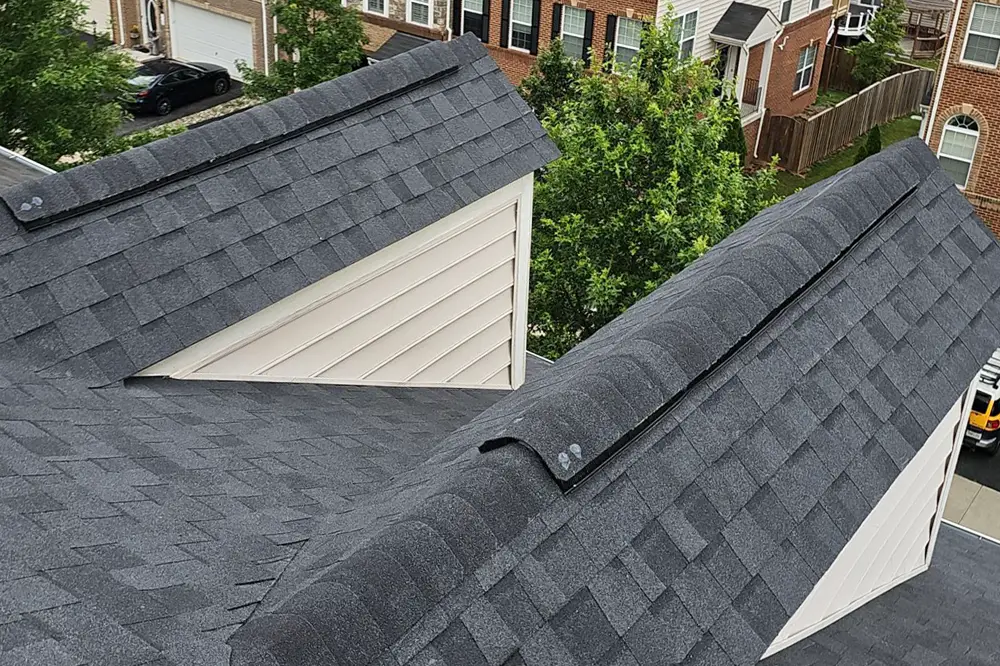- Services
- Storm & Hail Damage
Storm & Hail Damage in Loudoun County, VA
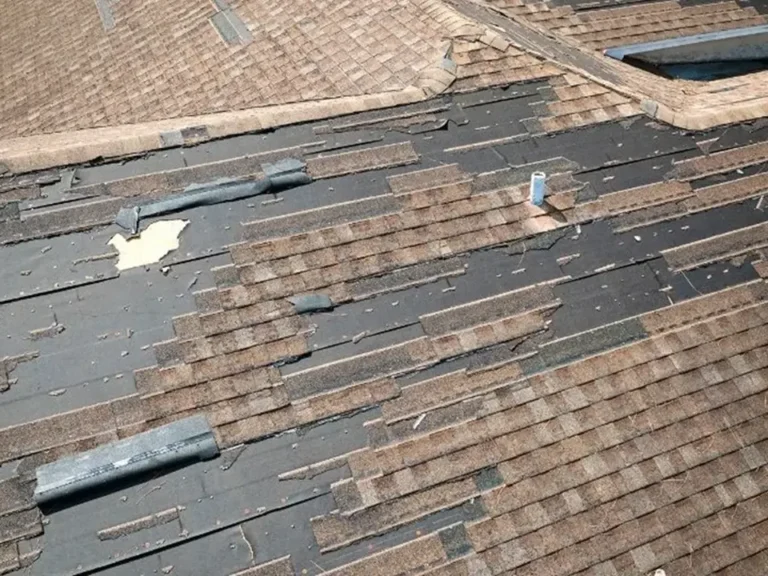

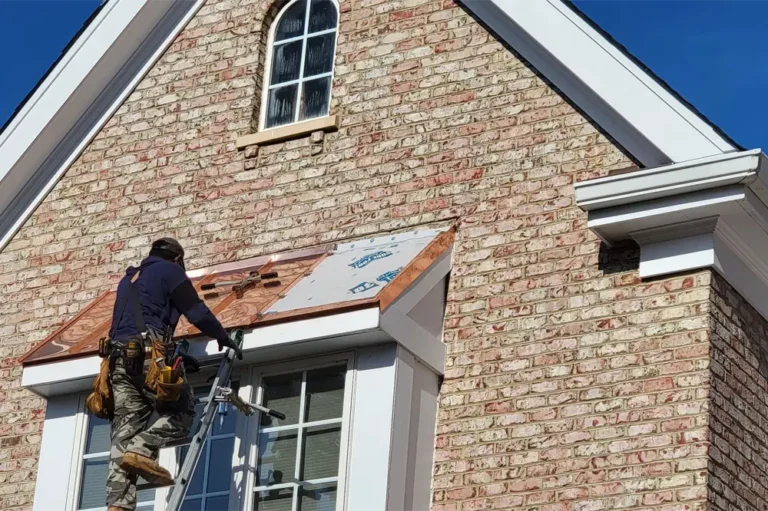
Storm & Hail Damage Services
When severe weather strikes, Loudoun Roofing stands ready with proven solutions and local expertise. Our storm and hail damage repair services are designed to deliver fast, honest, and lasting results, helping homeowners protect what matters most. Backed by years of experience responding to Virginia’s most damaging storms, we understand the specific risks Loudoun County homes face.
From hail impacts to high wind gusts and torrential thunderstorms, we’ve seen it all and fixed it all. As a trusted roofing contractor in Loudoun County, we offer responsive service, detailed inspections, and complete roof restoration to get your home back to pre-storm condition quickly and efficiently.
Understanding Storm & Hail Damage in Loudoun County
Loudoun County is no stranger to intense weather. According to the Virginia Department of Emergency Management (VDEM), severe storms, including hail, wind gusts over 60 mph, and EF0 tornadoes, are a recurring hazard in our area. In 2023 alone, Leesburg experienced 15 confirmed hail events, with sizes ranging from nickel- to golf ball-sized, damaging roofs, gutters, and siding across neighborhoods like Potomac Station and Greenway Boulevard.
As Loudoun County grows, so does its exposure to storm-related property damage. Whether you live in an older home in Downtown Leesburg or a newer build near the Executive Airport, no roof is immune to the effects of storm and hail damage in Loudoun County, VA.
Types of Storm & Hail Damage We Address
Storm damage in Loudoun County typically falls into three categories: hail, wind, and thunderstorm-related impacts.
- Hail damage often occurs during spring and summer, when hailstones as large as 1.75 inches strike roofs at high speeds. This impact can crack shingles, knock off protective granules, and damage flashing, skylights, and gutters. Even small dents can allow moisture to seep beneath the surface, causing hidden leaks and long-term deterioration.
- Wind damage is common during severe thunderstorms and high-wind warnings across Loudoun County. Gusts exceeding 60 mph can lift shingles, tear flashing, and send debris crashing into roof structures. We often see damage from fallen tree limbs and uplifted shingles, which weaken the system even when they don’t result in immediate leaks.
- Thunderstorm risks combine rain, debris, and pressure changes that lead to water intrusion, clogged gutters, and weakened seams. In some cases, EF0 tornadoes or intense microbursts in the region have caused full or partial roof detachment, especially in exposed neighborhoods.
At Loudoun Roofing, we know how to assess and repair each of these damage types to restore your roof’s integrity and prevent further problems. Need a full checkup? Schedule a professional roof inspection today.
roofing
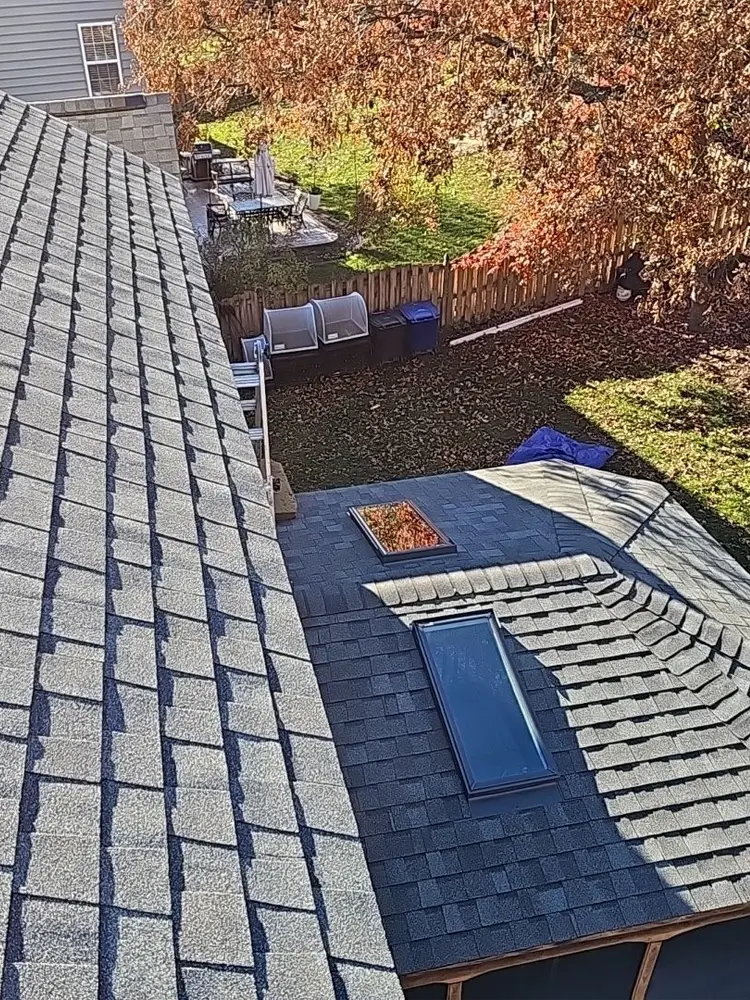
Our Services
Roofing Services
Our crews are trained in the latest safety protocols, material handling, and installation techniques. Each member is vetted, insured, and committed to getting the job done right the first time. We frequently complete OSHA-certified safety training and maintain up-to-date licenses.

What to Look for After a Storm
- Missing or lifted shingles can expose the underlayment and lead to costly water damage if not promptly repaired.
- Granules collecting in gutters often signal hail impact or aging shingles compromised by storm intensity.
- Ceiling stains or attic moisture point to active roof leaks caused by flashing failure or broken shingles.
- Dented vents or flashing are signs of hail impact that can weaken the roof’s weatherproofing and ventilation.
Debris on the roof may hide punctures or loose shingles; inspection is necessary to confirm roof integrity.
What to Do After Storm Damage in Loudoun County
- Stay off the roof and away from downed branches or power lines to avoid injury or structural collapse risks.
- Photograph visible damage to siding, gutters, and roofing to document conditions before cleanup or inspection.
- Call Loudoun Roofing immediately for emergency tarping, inspection, and help protecting your home from further damage.
- Contact your insurance company and start a claim with our support; our reports make the process smooth and fast.
- Schedule a full inspection so we can detect hidden damage, provide repair options, and restore your home quickly.
Our Storm & Hail Damage Services
Emergency Roof Tarping
Need coverage fast? We offer same-day tarping to prevent additional water damage. Ideal for exposed decking, leaks, or pre-inspection stabilization.
Storm Damage Inspection & Report
Using drones and visual assessments, we document:
- Damaged or lifted shingles
- Dents in soft metal components
- Moisture penetration or rot
- Attic insulation saturation
Our findings are delivered in a claim-ready report for your insurer. For details, see Roof Insurance Claims Explained.
Insurance Claim Assistance
We help you:
- File accurate claims with clear documentation
- Communicate with adjusters
- Get full coverage for hidden or delayed issues
Most insurance providers prefer working with a licensed roofing contractor in Northern Virginia, and we’re experienced in what insurers need.
Roof Repair & Replacement
Depending on the damage level, we perform:
- Roof repairs for shingle, vent, or flashing issues
- Full roof replacement when structural integrity is compromised
- Upgrades to impact-resistant asphalt shingles or metal roofing
Curious about roofing materials? See our Roofing Brands for trusted names like Owens Corning and CertainTeed.
Seasonal Demand for Storm and Hail Damage Repairs in Loudoun County, VA
The graph illustrates the seasonal demand for storm and hail damage repairs in Loudoun County, VA. The demand for repairs peaks during the summer months, with July and August showing the highest repair requests, at 40% and 45%, respectively. This is likely due to the increased occurrence of storms and hail during this period. The demand remains relatively high through May and June (25–30%) as spring storms also contribute to damage. The demand starts to decline after August, with September still experiencing 35% of the yearly demand. The lowest repair demands are seen during the winter months, particularly in January and February, with only about 10–12% of the total demand. This reflects the reduced frequency of severe weather in winter. Overall, storm and hail damage repairs are most concentrated during late spring to summer, aligning with the region’s peak storm season.
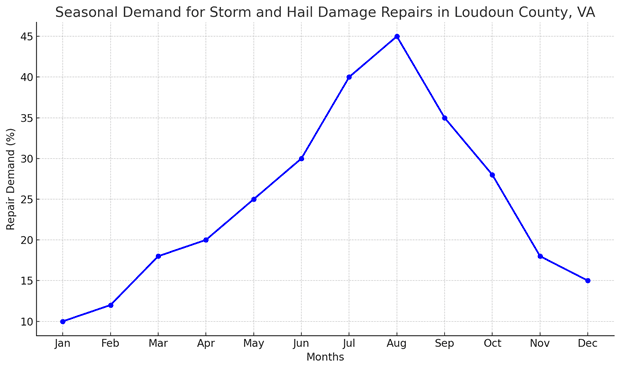
Why Choose Loudoun Roofing
- Locally based roofing contractor in Loudoun County, VA, with deep knowledge of Loudoun County storm patterns and property styles.
- Fast emergency response teams are available 7 days a week to assess storm damage and prevent further interior water intrusion.
- Clear, detailed roof reports used for insurance claims and estimating full-scope hail and wind restoration needs.
- Licensed, insured, and certified to perform residential roof repairs, replacements, and inspections after severe weather.
- Proven track record of honest service, 5-star testimonials, and long-standing relationships with Loudoun County homeowners.
Types of Storm & Hail Damage We Address
Storm damage in Loudoun County typically falls into three categories: hail, wind, and thunderstorm-related impacts.
- Hail damage often occurs during spring and summer, when hailstones as large as 1.75 inches strike roofs at high speeds. This impact can crack shingles, knock off protective granules, and damage flashing, skylights, and gutters. Even small dents can allow moisture to seep beneath the surface, causing hidden leaks and long-term deterioration.
- Wind damage is common during severe thunderstorms and high-wind warnings across Loudoun County. Gusts exceeding 60 mph can lift shingles, tear flashing, and send debris crashing into roof structures. We often see damage from fallen tree limbs and uplifted shingles, which weaken the system even when they don’t result in immediate leaks.
- Thunderstorm risks combine rain, debris, and pressure changes that lead to water intrusion, clogged gutters, and weakened seams. In some cases, EF0 tornadoes or intense microbursts in the region have caused full or partial roof detachment, especially in exposed neighborhoods.
At Loudoun Roofing, we know how to assess and repair each of these damage types to restore your roof’s integrity and prevent further problems. Need a full checkup? Schedule a professional roof inspection today.
Testimonials
What they’re saying about us
Frequently Asked Questions
How do I know if my roof has hail damage after a storm in Northern Virginia?
Signs of hail damage include dented shingles, granules in gutters, or soft spots on the roof surface. We offer free inspections in Northern Virginia to assess and document all storm-related damage.
Is hail damage to my roof covered by insurance in Loudoun County?
In most cases, yes. Homeowners’ insurance typically covers hail and wind damage. As a trusted roofing contractor in Loudoun County, we help you navigate the claims process from start to finish.
How quickly should I repair storm damage on my roof?
Immediately. Delaying repairs can lead to water intrusion and mold. We provide emergency roof tarping and same-day inspections to prevent further damage after storms in the Northern Virginia area.
Can I tell if my roof is damaged without climbing up there?
You might see missing shingles, gutter debris, or ceiling leaks, but many signs are hidden. That’s why we recommend a professional roof inspection after any major storm in Northern Virginia.
What size hail can damage a roof in Loudoun County?
Hail as small as 1 inch in diameter can damage shingles. In recent years, golf-ball-sized hail has been recorded near Loudoun County and other nearby neighborhoods.
Do you offer storm damage roof repairs for historic homes in Loudoun County?
Yes, we specialize in repairing and restoring roofs on both modern and historic properties in Loudoun County, using materials that match the home’s original style and meet code.
Get in Touch with Loudoun Roofing
Loudoun Roofing & Home Improvement
Leesburg, Virginia 20175
Monday: 6AM – 10PM
Tuesday: 6AM – 10PM
Wednesday: 6AM – 10PM
Thursday: 6AM – 10PM
Friday: 6AM – 10PM
Saturday: 8AM – 6PM
Sunday: 8AM – 4PM
Read Our Reviews on Google


